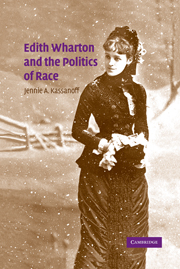Book contents
- Frontmatter
- Contents
- Acknowledgements
- Introduction
- 1 Invaders and Aborigines: playing Indian in the Land of Letters
- 2 “The real Lily Bart”: staging race in The House of Mirth
- 3 “A close corporation”: the body and the machine in The Fruit of the Tree
- 4 The Age of Experience: pragmatism, the Titanic and The Reef
- 5 Charity begins at home: Summer and the erotic tourist
- 6 Coda: The Age of Innocence and the Cesnola controversy
- Notes
- Bibliography
- Index
3 - “A close corporation”: the body and the machine in The Fruit of the Tree
Published online by Cambridge University Press: 22 September 2009
- Frontmatter
- Contents
- Acknowledgements
- Introduction
- 1 Invaders and Aborigines: playing Indian in the Land of Letters
- 2 “The real Lily Bart”: staging race in The House of Mirth
- 3 “A close corporation”: the body and the machine in The Fruit of the Tree
- 4 The Age of Experience: pragmatism, the Titanic and The Reef
- 5 Charity begins at home: Summer and the erotic tourist
- 6 Coda: The Age of Innocence and the Cesnola controversy
- Notes
- Bibliography
- Index
Summary
Between 1905 and 1911, Edith Wharton published three novels, each of which circulated with fascinated horror around the prone body of an immobilized woman. At the conclusion of The House of Mirth (1905), Lawrence Selden discovers “on a bed, with motionless hands and calm, unrecognizing face, the semblance of Lily Bart” (325). Six years later, in the culminating moments of her bleak New England tale, Ethan Frome (1911), Wharton's narrator discovers the dreadful source of Ethan's grief: the incapacitated body of a “much smaller and slighter” Mattie Silver:
She sat huddled in an arm-chair near the stove, and when I came in she turned her head quickly toward me, without the least corresponding movement of her body. Her hair was as grey as her companion's, her face as bloodless and shrivelled, but amber-tinted, with swarthy shadows sharpening her nose and hollowing the temples. Under her shapeless dress her body kept its limp immobility, and her dark eyes had the bright witch-like stare that disease of the spine sometimes gives.
(125)While Wharton would return to this image six years later in Summer's harrowing description of Mary Hyatt, whose body lies atop the Mountain “like a dead dog in a ditch” (Summer 163), The House of Mirth and Ethan Frome form an oddly compact trilogy with the less well-known novel that links them, The Fruit of the Tree (1907), Wharton's peculiar foray into the worlds of industrial reform, bodily paralysis and euthanasia.
- Type
- Chapter
- Information
- Edith Wharton and the Politics of Race , pp. 59 - 82Publisher: Cambridge University PressPrint publication year: 2004

